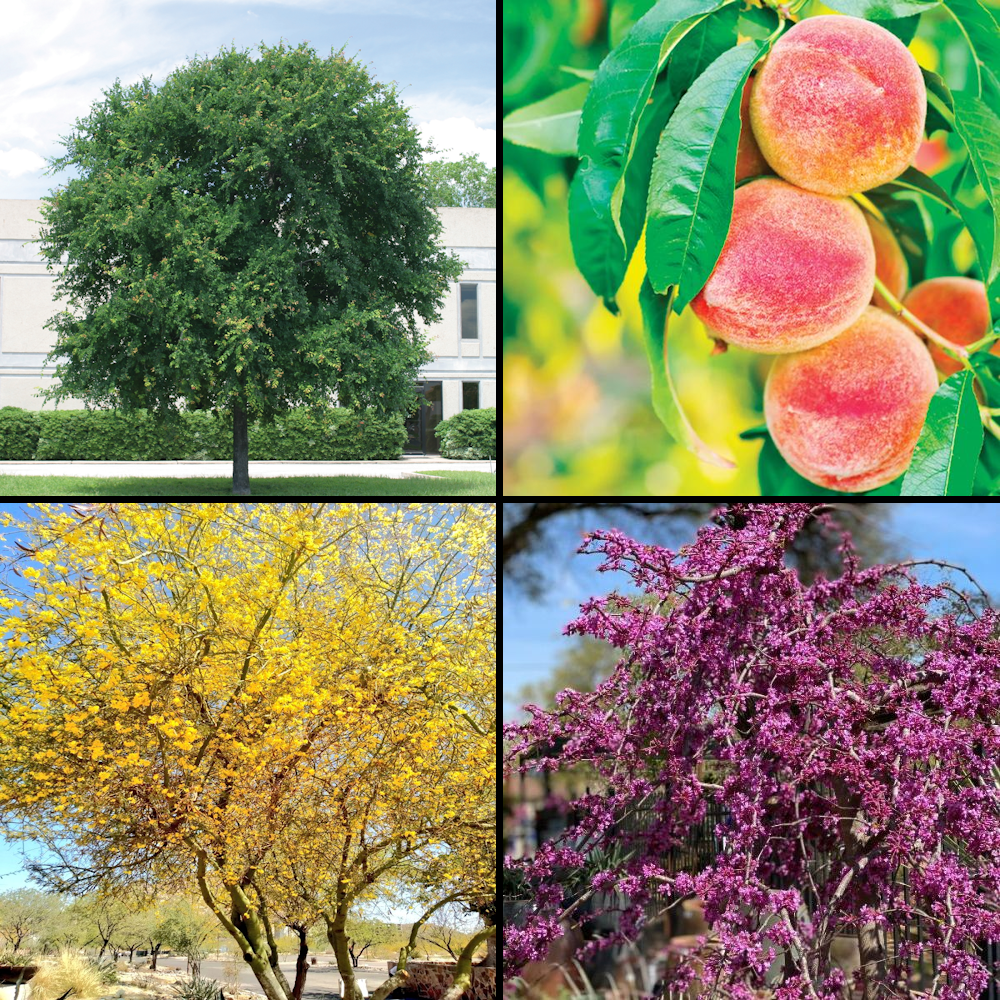
I love trees and you should too! Whether we’re talking about huge heritage Oaks, beautiful flowering Redbuds, or wonderfully juicy peaches, there’s the perfect tree for your yard.
One of the most important, and often difficult, aspects of growing a tree starts at the very beginning: selecting the right tree for your space. We should begin by examining the area where we want a tree. Measure the space to figure out what size tree would be appropriate for this specific area. Are there structures nearby? Other trees to compete with? We need to pick the right size tree for the right sized space. Keep in mind the mature size of the tree and make sure there is adequate space for it.
Is this a full sun spot, or are we planting an ornamental tree under one of our mature live oaks? Different trees will require different amounts of direct sunlight. Make notes throughout the day to determine if you have full sun (6+ hours of direct sunlight), part sun (3-6 hours of direct sunlight), or full shade. Also note if the direct sun is in the morning or afternoon, this can make a huge difference!
The next aspect to consider is how much work you’re willing to put into this plant in the long term. It’s always best to work with native or adapted plant material. These plants are accustomed to our terrible soil and harsh climate and thus will be less maintenance. If you’re dead set on trying out something unique that isn’t acclimated to central Texas, keep in mind the regular maintenance that will come with it.
Just as there are many excellent choices when it comes to trees, there are a few options out there that you should stay away from. Whether it’s because they’re an invasive species or because they don’t thrive the way we want them to, here’s a short list of trees we encourage you to shy away from.
Texas Ash - The emerald ash borer is an incredibly destructive pest. Don’t bother. Read more here.
Chinese Pistache - Once mature, this tree can produce large quantities of seeds that can out-compete native plant species. Read more here.
Mexican Sycamore - Not invasive like the previous two, but still has problems. It grows too fast for its own good so new branches can break in our high winds. The leaves take forever to drop so you’re constantly raking all winter. Large seeds drop and can be a pain to pick up.
Now for the fun part! This is a compilation of my favorite trees for central Texas broken down into Shade, Ornamental, and Fruit. This is not a complete list, as there are quite a few trees that could work for your needs (especially fruit), but a list of trees that I’ve seen do the best for our area.
Shade: Shade trees are incredibly important to have in your landscape for the shelter and food they provide for the native wildlife and the value that it brings to your home. These large beauties can take time to really shine, but the payoff is worth it in the end. Below is a list of my favorites.
Ornamental: Ornamental trees come in all sorts of shapes and colors and can add much-needed curb appeal to your home. Typically grown as individual statement pieces, these smaller trees will add beauty to your home.
Fruit: Fruit trees can be the most rewarding tree of all. Tasting the fruit of your labor is one of the most satisfying feelings in the world. Anything from a stately pomegranate to a brambling blackberry can be enjoyed by just about anyone. There are dozens of varieties of each fruit to choose from, but we want to pick the ones best suited for central Texas. Here are my favorites.
Just as important as tree selection, proper planting techniques will ensure that your tree gets established quickly and will thrive. Please read over our tree-planting guide here.
Using amendments when planting a new tree is extremely important in the establishing process. When we do a tree installation, we require that you purchase compost and mulch, that’s how vital we believe these two amendments are to the health of the plant. Compost will help improve soil composition and add much-needed nutrients. Mulch will help with water retention, weed prevention, and temperature regulation. We also highly suggest the use of an organic fertilizer to encourage fast and vigorous root development. Microlife Multi Purpose organic biological fertilizer is the best. I personally use this on everything that I grow.
Now that your tree is planted, you may be asking yourself, “How do I care for this thing?” And that’s a valid question. There is a lot of different information online, and that’s mainly because there isn’t one true answer to cover every tree. Conditions such as light, drainage, and time of the year are huge factors in determining how to care for your tree
The main point is watering. Trees like to be watered deeply and infrequently to let the soil dry out. If watering by hand, I generally recommend running your hose on a slow drip for about 30-40 minutes to fully saturate the root ball and surrounding soil. Then give it time to dry out before watering again. The time to wait between waterings will vary based on soil composition, type of tree, direct sun available, and time of the year. A moisture meter can be a nice tool to help determine how wet your soil is.
Pruning is another part of care and maintenance that will vary drastically based on what you’re growing. Large shade trees should be left to professional arborists to prune. Some fruit trees, like stone fruits (peaches, plums, etc.) should be pruned in a specific shape to get the best production. And some fruit and ornamentals can be left alone and will be totally fine.
There are many wonderful benefits to adding trees to your landscape; shade trees can shade your home in the harsh summertime, ornamental trees can add beauty and curb appeal, and fruit trees can provide tasty food! Selecting the right tree for the right space is crucial and adhering to proper planting techniques is essential. Trees are essential and beautiful, so hopefully you’ve found the right one for your yard!

You must be logged in to post a comment.